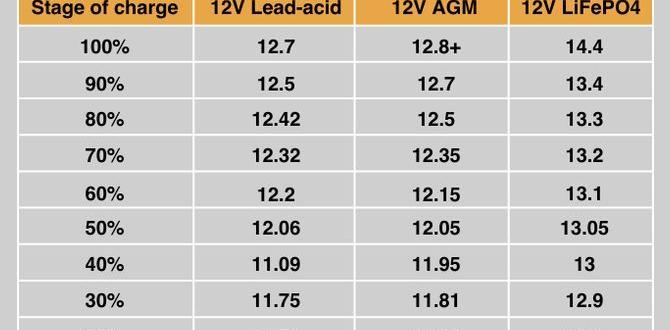Choosing the right battery for your smoke detector is crucial for safety. Most detectors use either 9-volt batteries or AA alkaline batteries. Lifespan, power, and cost vary. This guide breaks down the types, helping you make the best choice to keep your home protected.
Smoke detectors are quiet guardians, always on duty to alert you to danger. But like any electronic device, they need power to work. The most common power source is a battery, and knowing which type to use is super important. It’s a little detail that can make a big difference when it matters most. Sometimes, a battery dies, and we’re left wondering, “What kind of battery did it take again?” This can be frustrating, especially when you need a quick replacement. Don’t worry, we’ll walk through it step-by-step. This guide will help you understand all the battery types for your smoke detector, so you can feel confident and prepared.
Understanding Your Smoke Detector’s Battery Needs
Most smoke detectors run on batteries, acting as a backup power source even if they’re hardwired into your home’s electrical system. This backup is vital. If the power goes out, your smoke detector still has the juice to keep sounding the alarm. The type of battery used can affect how long it lasts, how often you need to replace it, and even the detector’s performance. It’s not just about grabbing any battery off the shelf; it’s about selecting the right one for reliable protection. We’ll cover the most common types you’ll find and what makes them tick.
Common Types of Batteries for Smoke Detectors
When it comes to keeping your smoke detectors powered up and ready, there are a few key battery types you’ll encounter. Each has its own set of characteristics, like how long they last and how strong their power output is. Understanding these differences helps you choose the best option for your peace of mind.
9-Volt Batteries
Ah, the classic 9-volt. You’ve probably seen these blocky batteries before. They’re a very common choice for many smoke detectors, especially older models or certain types of alarms like ionization or photoelectric detectors. The 9-volt battery is known for providing a steady amount of power needed to operate the sensor and the loud alarm.
Pros of 9-Volt Batteries:
- Widely available in stores.
- Relatively inexpensive per unit.
- Often provide a good balance of power and lifespan for many detector models.
Cons of 9-Volt Batteries:
- Can sometimes have a shorter lifespan compared to other options, especially if the detector is older or more sensitive.
- They tend to drain their power more gradually, meaning the chirping warning might start sooner and last longer before the battery is completely dead.
When buying a 9-volt, you’ll often find them in alkaline or lithium versions. For smoke detectors, alkaline is standard, but lithium batteries offer a significantly longer life, often lasting up to 10 years! However, they come with a higher upfront cost. Always check your smoke detector’s manual to see if it supports lithium 9-volt batteries, as not all models are designed for them.
AA and AAA Batteries
You’re probably very familiar with AA and AAA batteries – they power most of our everyday gadgets, from remote controls to toys. Increasingly, smoke detector manufacturers are opting for these cylindrical batteries, especially in newer models, dual-sensor alarms, or smart smoke detectors. These detectors often use two or more AA batteries.
Pros of AA/AAA Batteries:
- Extremely common and easy to find.
- Often available in bulk packs, which can be cost-effective for multiple detectors.
- Lithium versions of AA and AAA batteries are readily available and offer a very long lifespan (often 5-10 years) and stable performance in extreme temperatures.
Cons of AA/AAA Batteries:
- The detector might need more than one, so you need the correct quantity.
- The lifespan can vary greatly depending on the brand, type (alkaline, NiMH, lithium), and manufacturer’s recommendations for the specific detector.
For smoke detectors, it’s best to use high-quality alkaline batteries or, for extended life and stability, lithium batteries specifically designed for long-term use in devices like smoke alarms. Rechargeable NiMH batteries are an option for some devices, but for smoke detectors, single-use lithium batteries are generally recommended for their reliability and longevity.
Specialized Batteries (e.g., Lithium Backup Batteries)
Some advanced smoke detectors, particularly those with Wi-Fi connectivity, smart features, or integrated sealed batteries, might use specialized power solutions. This can include long-life sealed lithium batteries that are part of the unit and designed to last the entire lifespan of the detector (often 10 years) or specific battery packs that serve as a backup.
Pros of Specialized Batteries:
- Designed for the specific detector, ensuring optimal performance and longevity.
- Often come with a very long lifespan, reducing the need for frequent battery changes.
- Sealed units mean you don’t have to worry about compatibility or replacing them often – they last the life of the device.
Cons of Specialized Batteries:
- When they do need replacement, it usually means replacing the entire smoke detector unit.
- Can be more expensive if a specific battery pack needs to be purchased separately.
- Not interchangeable with standard batteries.
These specialized batteries are becoming more common as smoke detectors evolve into smarter safety devices. Always refer to your detector’s manual to identify its specific battery requirements.
Battery Lifespan and Replacement Schedules
Knowing what battery to use is one thing, but knowing when to change it is just as vital. Smoke detector batteries don’t last forever, and a dead battery means no alarm. Setting up a reliable replacement schedule is key to staying protected.
Typical Lifespans
The lifespan of a smoke detector battery depends on several factors: the type of battery, the brand, and how much power the detector uses. Here’s a general idea:
- Standard Alkaline 9-Volt Batteries: Typically last 6-12 months.
- Standard Alkaline AA/AAA Batteries: Can last 1-3 years, especially if the detector uses multiple batteries and they are of good quality.
- Lithium 9-Volt Batteries: Can last 5-10 years.
- Lithium AA/AAA Batteries: Can last 5-10 years, often matching the lifespan of the detector itself.
- Sealed Long-Life Lithium Batteries: Designed to last the entire 10-year lifespan of the smoke detector unit.
When to Replace – The Chirp vs. Dead Battery
Most smoke detectors will give you a warning before the battery completely dies. This is usually a short, intermittent chirp every minute or so. Don’t ignore this sound! It’s the detector’s way of telling you it’s time for a new battery.
Tip: A good practice is to replace the batteries in all your smoke detectors at least once a year. A common reminder is to do it when you change your clocks for daylight saving time twice a year, though if you use long-life lithium batteries, you can stretch this out much further.
Factors Affecting Battery Life
- Detector Age and Model: Older detectors might draw more power. Newer, energy-efficient models can extend battery life.
- Battery Quality: Higher-quality batteries, especially lithium ones, generally last longer and perform more reliably.
- Environmental Conditions: Extreme temperatures (hot or cold) can shorten battery life.
- Power Outages: If your smoke detector relies on battery backup during frequent power outages, it will drain the battery faster.
- Low Battery Warning Chirps: The chirping itself uses battery power, so the sooner you address the chirp with a new battery, the less power is wasted.
Choosing the Best Battery: Pros and Cons at a Glance
Making an informed decision about which battery to put in your smoke detector is easy when you compare the options side-by-side. Here’s a quick look at how the popular choices stack up:
| Battery Type | Lifespan (Typical) | Power Output | Cost (per battery) | Availability | Best For |
|---|---|---|---|---|---|
| Alkaline 9-Volt | 6-12 months | Steady | Low (around $1-$3) | Very high | Older detectors, budget-conscious users needing frequent checks. |
| Lithium 9-Volt | 5-10 years | Steady, stable | High (around $5-$10) | Good, but less common than alkaline. | Users wanting long-term worry-free power, compatible detectors. |
| Alkaline AA/AAA | 1-3 years (depends on quantity/usage) | Moderate | Low (around $0.50-$2 per battery) | Very high | Newer detectors, dual-sensor alarms, budget-conscious users. |
| Lithium AA/AAA | 5-10 years | Stable, can be higher | Moderate to High (around $2-$5 per battery) | Good, readily available. | Users prioritizing long life and stable performance, many modern detectors. |
| Sealed Lithium (Part of Detector) | ~10 years (life of detector) | Optimized | N/A (included with unit) | N/A (integral part) | Smart detectors, enhanced safety units designed for a decade of use. |
Safety First: When Replacing Smoke Detector Batteries
Replacing smoke detector batteries is a simple task, but like anything involving electricity and safety devices, it’s good to follow a few best practices to ensure you do it right and keep your home protected.
Step-by-Step Battery Replacement
Always refer to your specific smoke detector’s manual for exact instructions, but here’s a general guide:
- Prepare the New Battery: Make sure you have the correct type and size of battery. It’s also a good idea to have the new battery ready to insert immediately.
- Turn Off or Remove the Detector: For most detectors, you’ll need to twist the unit to detach it from its mounting bracket. Some detectors have a switch, or you can gently press a button to disable it temporarily before removing the battery to prevent nuisance alarms.
- Open the Battery Compartment: This is usually a small door or panel on the back or side of the detector. It might slide open or have a small clip you need to press.
- Remove the Old Battery: Note the orientation of the battery (positive and negative ends). If it’s a 9-volt, you’ll need to unclip the connector. If it’s AA or AAA, they usually slide out easily.
- Insert the New Battery: Place the new battery in the compartment, matching the positive (+) and negative (-) terminals correctly. If it’s a 9-volt, connect the clip first, then position the battery.
- Close the Compartment: Securely close the battery compartment door or panel.
- Test the Smoke Detector: This is the most important step! Press and hold the test button on the smoke detector for a few seconds. You should hear a loud, clear alarm sound. If you don’t, double-check the battery connection and try again.
- Reattach the Detector: If you removed the detector from its bracket, reattach it securely.
Important Safety Tips
- Never ignore the low battery chirp: This alert is crucial, and a chirping detector is a warning that your home is less protected. Replace the battery immediately.
- Use the specified battery type: Always check your manual to ensure you are using the correct battery size and type (alkaline, lithium, etc.). Using incorrect batteries can damage the detector or shorten its life. For example, some detectors are not designed for rechargeable batteries, which can have a lower and less stable voltage.
- Do not use rechargeable batteries unless specified: Standard smoke detectors are designed for the consistent voltage of non-rechargeable alkaline or lithium batteries. Rechargeable batteries can have a lower voltage and might not power the alarm effectively.
- Dispose of old batteries properly: Many household batteries contain chemicals. Check with your local waste disposal services for guidelines on recycling or disposing of used batteries. For instance, according to the U.S. Environmental Protection Agency (EPA), certain types of batteries, like rechargeable ones, should be recycled.
- Consider dual-sensor detectors: These use both ionization and photoelectric sensors for broader detection capabilities. They often use AA batteries and benefit greatly from the long life of lithium AA batteries.
- Keep your detectors clean: Dust and debris can interfere with a smoke detector’s ability to sense smoke. Gently vacuum your detectors when you change the batteries.
Maintaining Multiple Smoke Detectors
Most homes have multiple smoke detectors – one on every level, one outside sleeping areas, and even inside bedrooms. Keeping them all powered and functional requires a bit of organization.
Creating a Battery Replacement Schedule
To avoid the dreaded “chirp” and ensure all your detectors are always ready, set up a system.
- The Daylight Saving Time Method: This is a popular and effective strategy. When you change your clocks forward in the spring and backward in the fall, make it a ritual to check and replace the batteries in all your smoke detectors. This ensures you’re addressing them twice a year as a minimum.
- The Annual Deep Clean:** If you use long-life lithium batteries (5-10 years), you might not need to change them every six months. Instead, designate one day a year (perhaps your birthday, or during your home’s annual deep clean) to test all your detectors and replace batteries if they are nearing their end-of-life or if you’re uncertain of their age.
- Labeling: For detectors with batteries that last a year or more, consider writing the installation date with a permanent marker on the battery itself or on a small sticker near the battery compartment. This helps you track how long the battery has been in use and when it’s likely due for replacement.
Testing is Non-Negotiable
No matter which battery type you choose, testing your smoke detectors regularly is paramount. Aim to test each detector at least once a month.
- Press and hold the test button until the alarm sounds.
- If the alarm is weak or doesn’t sound, it’s time to replace the battery (or the detector if it’s very old).
- Ensure the test button is fully functional. Sometimes, the button can become less responsive over time.
Remember, the battery is just one part of a functioning smoke detector. The detector itself has a lifespan, typically around 10 years. Check the manufacturing date on your detector and replace it if it’s expired, regardless of the battery type.
Frequently Asked Questions About Smoke Detector Batteries
Q1: What is the most common type of battery for smoke detectors?
A1: The most common types are the 9-volt battery and AA or AAA alkaline batteries. 9-volt batteries are often found in older or simpler models, while AA/AAA are increasingly used in newer, multi-sensor, or smart detectors.
Q2: How long should a smoke detector battery last?
A2: This varies greatly. Standard alkaline 9-volt batteries might last 6-12 months. Higher-quality alkaline AA/AAA can last 1-3 years. Long-life lithium batteries (both 9-volt and AA/AAA) are designed to last 5-10 years. Sealed batteries in some detectors last the entire 10-year life of the unit.
Q3: Can I use rechargeable batteries in my smoke detector?
A3: Generally, it’s not recommended unless your smoke detector’s manual specifically states that it is designed for rechargeable batteries. Standard detectors need the consistent, higher voltage of alkaline or lithium batteries to function properly. Rechargeable batteries can have a lower voltage and may not power the alarm sufficiently.
Q4: My smoke detector is chirping. Does it mean the battery is dead?
A4: Yes, the intermittent chirp (usually once a minute) is almost always a warning that the battery is low and needs to be replaced soon. It’s designed to alert you before the battery completely fails.
Q5: Do all smoke detectors use the same battery?
A5: No, but most use either 9-volt or




